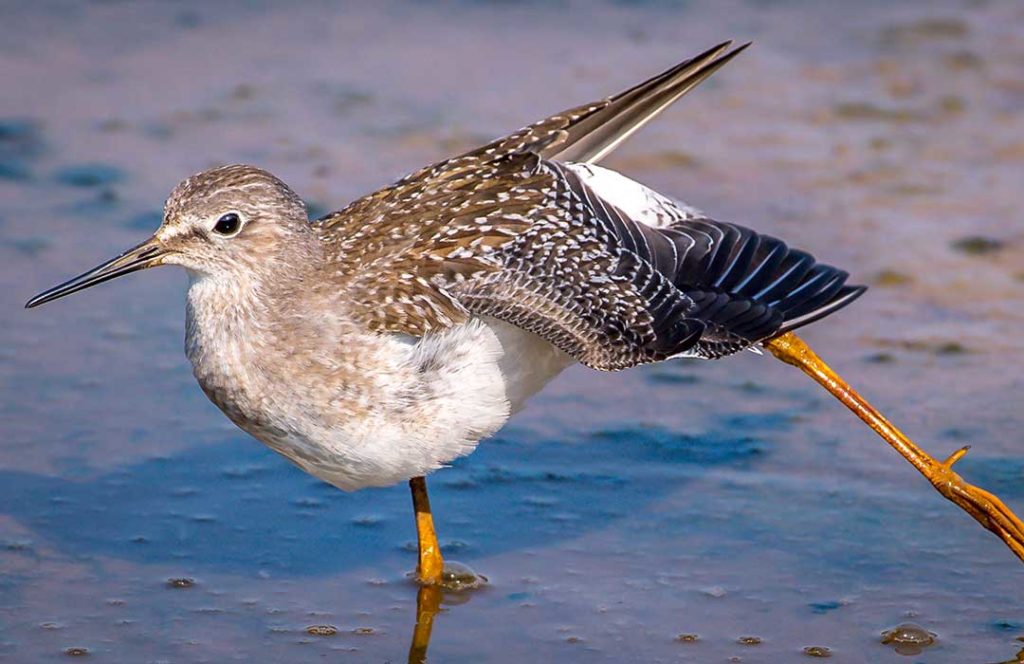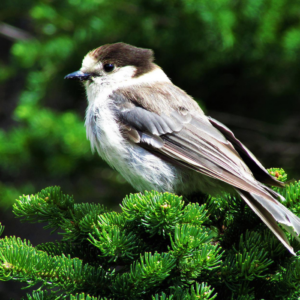Get To Know This Year’s Featured World Migratory Bird Day Species: The Lesser Yellowlegs

VITAL SIGNS
- Common name: Lesser Yellowlegs
- Latin name: Tringa flavipes
- Range: Non-breeding periods are spent mainly in Central and South America. Individuals migrate North to breeding areas in Northwestern Canadian provinces and Alaska. Can be found in all Canadian provinces/territories except for the Maritimes.
- Lifespan: Approximately 4 years.2
- Size: Length anywhere from 23-27cm with a wingspan of 59-64 cm.1
- COSEWIC Status: Listed as Threatened since 2020
- Population estimate: There are an estimated 527,000 individuals in North America, with 80% of this population breeding in Canada2
THE FACTS
The Lesser Yellowlegs migrate in loose flocks and can travel up to 30,000 km round trip from their wintering to their breeding locations.2 Common wintering locations include agricultural fields Breeding areas largely lie in the Canadian Boreal forest region. Individuals tend to nest in dry areas near peatlands, marshes, and ponds. During migration season they can also be found in salt marshes, estuaries, and freshwater wetlands.2 Their diet consists mainly of terrestrial and aquatic invertebrates-snails, flies, beetles, occasionally small fish and seeds.1
Females will usually lay a single clutch of eggs but can lay a second depending on the survival of the first. Clutches typically consist of 3-5 eggs.2 Upon hatching, birds are able to walk and typically leave the nest to feed themselves within a few hours. Individuals are typically calm and non-confrontational, aside from during breeding periods or near nesting sites.
Despite having similar names and features, the Lesser Yellowlegs is more closely related to the Willet than it is to the Greater Yellowlegs!1
THE STORY
It has recently been estimated that the Lesser Yellowlegs will experience greater population declines due to habitat loss. Populations have already experienced declines of up to 25% over three generations (about 12 years) in Canada2 and are expected to decline further. The main concern associated with the Lesser Yellowlegs is the loss of wetland habitats, which are crucial for the bird’s migration patterns.2 Hunting, for both sport and food, is one of the most significant threats to the lesser yellowlegs.2 Individuals were hunted incessantly in the early 20th century, but hunting numbers decreased with the introduction of the Migratory Bird Treaty Act in 1918 which banned the hunting of over 1000 migratory bird species.1
WHAT IS BEING DONE
The species was ranked “vulnerable” in five Canadian provinces by NatureServe.2 It is also protected in Canada under the Migratory Birds Convention Act (1994)2. In 2013, the Lesser Yellowlegs were designated as a priority species according to Bird Conservation Region Strategy3. Classified as “secure” according to recent reports3 and Lesser Yellowlegs is listed as a species of least concern under IUCN global3. Designated as “Threatened” by a 2020 COSEWIC assessment2.
WHAT YOU CAN DO
Climate change plays a major role in the destruction of wetland habitats and the disturbance of boreal areas, which are important for the reproduction of the Lesser Yellowlegs. Advocating against the negative consequences of climate change and the protection of ecologically diverse areas (such as wetlands) is a great way to help this species and a number of others.
You can also take action in your community by getting involved with a local Bird Team in your community to work towards becoming Bird Friendly City Certified and by Hosting and participating in an upcoming World Migratory Bird Day event near you!
- 1The Cornell Lab, 2019. All About Birds, Lesser Yellowlegs https://www.allaboutbirds.org/guide/Lesser_Yellowlegs/id
- 2Government of Canada, 2020. Lesser Yellowlegs : COSEWIC assessment and status report 2020. https://www.canada.ca/en/environment-climate-change/services/species-risk-public-registry/cosewic-assessments-status-reports/lesser-yellowlegs-2020.html
- 3Canadian Wildlife Service Waterfowl Committee. 2015. Population of Migratory Birds in Canada. https://wildlife-species.canada.ca/bird-status/oiseau-bird-eng.aspx?sY=2014&sL=e&sM=c&sB=LEYE



